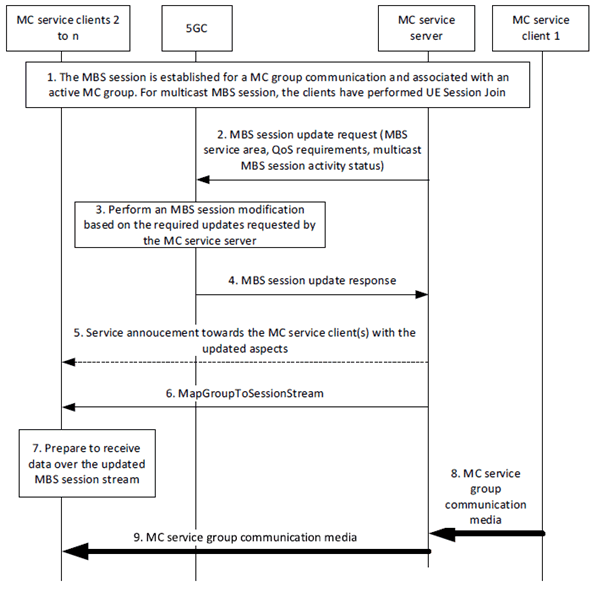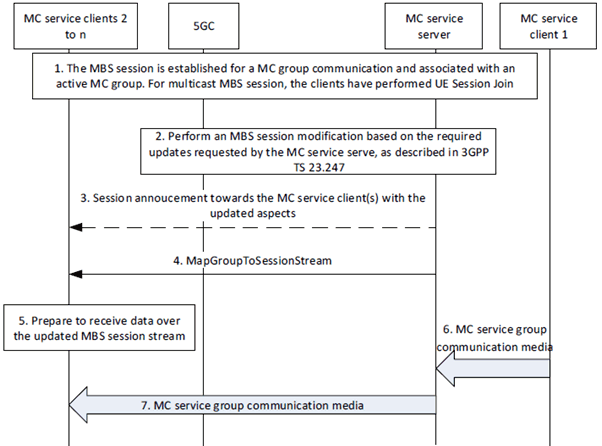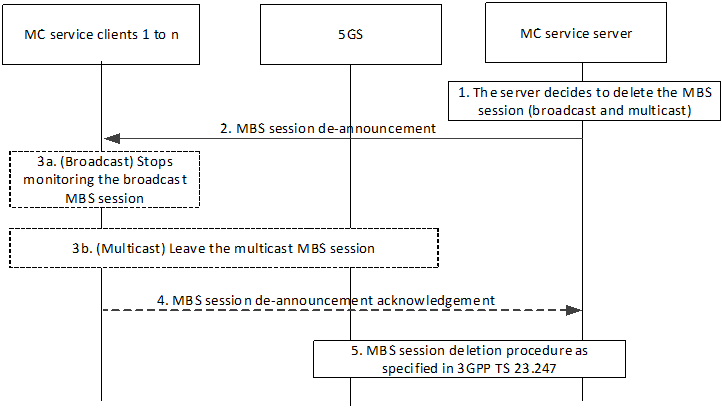Content for TS 23.289 Word version: 19.0.0
0…
4…
4.7…
4.7.4…
4.8…
5…
5.4…
6…
6.3…
6.3.2…
7…
7.2.4…
7.3…
7.3.3…
7.3.3.2…
7.3.3.4…
7.3.3.5…
7.3.3.7…
7.3.3.8…
7.3.3.9…
7.3.3.10…
7.3.3.11…
7.3.3.12…
7.3.3.13…
7.4…
7.5…
7.6…
A…
7.3.3.2 Request for updating MBS resources for group communications
7.3.3.2.1 General
7.3.3.2.2 Procedure for updating MBS resources without dynamic PCC rule
7.3.3.2.3 Procedure for updating MBS resources with dynamic PCC rule
7.3.3.3 MBS session deletion request
...
...
7.3.3.2 Request for updating MBS resources for group communications p. 61
7.3.3.2.1 General p. 61
The MC service server can create one or several MBS sessions based on certain service requirements (e.g., QoS profile), a certain service area, or the activity status of multicast MBS sessions. However, during the life cycle of the MBS sessions, the MC service server may need to update the sessions to meet emerging needs, including the service requirements, service area related parameters, etc., as defined in TS 23.247.
In case of dynamic PCC rule, the MC service server needs to determine what aspects are needed to be updated (either service area related aspects/ multicast activation status, service requirements aspects, or both as described in TS 23.247) in order to interact with the required entity in the 5GC either directly, (in case the MC service server is in trusted domain), or indirectly via NEF/MBSF.
7.3.3.2.2 Procedure for updating MBS resources without dynamic PCC rule p. 61
The procedure shown in Figure 7.3.3.2.2-1 presents an MBS session update procedure triggered by the MC service server (either directly to the MB-SMF, or indirectly via NEF/MBSF). Within the update request, either the service requirements, MBS service area, activity status of multicast MBS session, or all three are done, as indicated in TS 23.247.
Pre-conditions:
- The MC service clients 1 to n are attached to the 5GS, registered and affiliated to the same active MC service group.
- The MC service server has obtained the required information related to the MB-SMF, either locally configured or during initial session configuration.
- The MBS session is created with certain service requirements and optionally with a certain broadcast/multicast service area. The MBS session is announced to be associated with the MC service group for group communication purposes.

Step 1.
An MBS session is established as described in in TS 23.247 (either a multicast or a broadcast session), and associated with a certain active MC group for group communication purposes. In the case of a multicast MBS session, the MC service clients have already joined the session.
Step 2.
The MC service server invokes an MBS session update request towards the 5GC (either directly to the MB-SMF or indirectly via NEF/MBSF) once the need has emerged to modify some aspects for the given MBS session under consideration. Hence, the MC service server sends the MBS session update request as described in TS 23.247 and either directly to the MB-SMF or indirectly via NEF/MBSF, indicating the MBS session ID to be updated. Along with the update request, the updated aspects are sent, which are either service requirements (required QoS), service area, or both. In case of multicast MBS sessions, the MC service server may as well update the status (active or inactive) of the multicast MBS session once needed within the update request.
Step 3.
Based on the needed requirements, the corresponding MBS session is accordingly modified, as indicated in TS 23.247. The update may lead to QoS Flow(s) addition, modification, or removal.
Step 4.
The MC service server receives an MBS session update response as described in TS 23.247, once the requested modifications are performed, and the indicated MBS session is updated accordingly.
Step 5.
The MC service server may initiate a session announcement towards the MC service clients associated with the ongoing session in order to announce the updated information, if required, e.g., the updated service area or SDP information.
Step 6.
The MC service server sends an MapGroupToSessionStream over the configured MBS session providing the required information to receive the media related to the established MC service group communication.
Step 7.
The MC service clients process the received information over the MapGroupToSessionStream in order to receive the associated MC media over the specific MBS session stream.
Step 8.
MC service client 1 sends media to the MC service server over unicast to be distributed for the established group communication.
Step 9.
The MC service server distributes the MC media to the MC services clients 2 to n over the indicated streams.
7.3.3.2.3 Procedure for updating MBS resources with dynamic PCC rule p. 63
The procedure shown in Figure 7.3.3.2.3-1 presents an MBS session update procedure triggered by the MC service server to the 5GC, either directly or via NEF/MBSF. Based on the required updates to be done, the MC service server needs to interact with the MB-SMF to update the MBS service area and multicast activity status, with the PCF to update the required QoS requirements, or sequentially both to update all the above, as indicated in TS 23.247.
Pre-conditions:
- The MC service clients 1 to n are attached to the 5GS, registered and affiliated to the same active MC service group.
- The MC service server has obtained the required information related to the MB-SMF, either locally configured or during initial session configuration.
- The MBS session is created with certain service requirements and optionally with a certain broadcast/multicast service area. The MBS session is announced to be associated with the MC service group for group communication purposes.

Step 1.
An MBS session is established as described in TS 23.247 (either a multicast or a broadcast MBS session), and associated with a certain active MC group for group communication purposes. In the case of a multicast MBS session, the MC service clients have already joined the MBS session.
Step 2.
The MC service server, based on the update requirements (i.e., MBS service area and/or the multicast MBS session activity status as well as the service requirements), perform the MBS session update with PCC procedure towards the 5GS as described in TS 23.247 and/or the MBS session activate/deactivate procedure as described in clause 7.3.3.4.
Step 3.
The MC service server may initiate a MBS session announcement towards the MC service clients associated with the ongoing MBS session in order to announce the updated information if required, e.g., the updated service area or SDP information.
Step 4.
The MC service server sends an MapGroupToSessionStream over the MBS session providing the required information to receive the media related to the established MC service group communication.
Step 5.
The MC service clients process the received information over the MapGroupToSessionStream in order to receive the associated MC media over the specific MBS session stream.
Step 6.
MC service client 1 sends media to the MC service server over unicast to be distributed for the established group communication.
Step 7.
The MC service server distributes the MC media to the MC services clients 2 to n over the indicated streams.
7.3.3.3 MBS session deletion request p. 64
7.3.3.3.1 General p. 64
The MC service server can decide to release a certain MBS session once it is no longer further utilized for the associated MC service group communication, e.g., the MC service group is no longer active, the MC media transmission is over and no further MC media to be delivered, group communication is terminated. The MBS session deletion procedure leads to releasing the network resources associated to that MBS session.
To delete the MBS session, the MC service server sends an MBS session deletion request to the 5GS providing the corresponding MBS session ID. The MBS session deletion request is sent to the MB-SMF (directly or via NEF/MBSF) when PCC is not used. However, if dynamic PCC rule is utilized, a policy authorization deletion request is initially sent to the PCF. Further details are provided in TS 23.247.
MC service server further informs the MC service client with the MBS session de-announcement, so that the MC client UE stops monitoring the broadcast MBS session or leaves the multicast MBS session. This procedure is applied for both broadcast MBS session and multicast MBS session.
7.3.3.3.2 Procedure p. 65
The procedure in Figure 7.3.3.3.2-1 describes the MBS session deletion aspects for group communication.
Pre-conditions:
- MC service clients 1 to n are attached to the 5GS, registered and affiliated to the same active MC service group.
- An MBS session is configured to address the corresponding MC service group with certain service requirements and optionally with a certain broadcast/multicast service area. The session is announced and established for group communication purposes for the MC service group.

Step 1.
The MC service server decides to delete the MBS session for the associated MC group communication, either multicast or broadcast session.
Step 2.
The MC service server sends an MBS session de-announcement message with the MBS session ID towards the MC service client(s). Upon receiving the MBS session de-announcement message, either 3a or 3b is performed.
Step 3a.
If the MBS session identified by MBS session ID is a broadcast MBS session, the MC service client(s) stops monitoring the broadcast MBS session and removes the broadcast MBS session related information.
Step 3b.
If the MBS session identified by MBS session ID is a multicast MBS session, the joined MC service client(s) initiate an MBS session leave procedure to leave the indicated MBS session in order to release the respective network resources, as defined in TS 23.247.
Step 4.
Subsequently, the MC service clients may send an MBS session de-announcement acknowledgement message to the MC service server indicating the status of MBS session.
Step 5.
The MC service server initiates the MBS session deletion procedure with the 5GC (either directly or through NEF/MBSF) in order to stop using the configured MBS session and release the corresponding network resources. The MC service server indicates within the MBS session release request the corresponding MBS session ID. The MBS session deletion procedure can either be with or without a dynamic PCC rule, as indicated in TS 23.247.